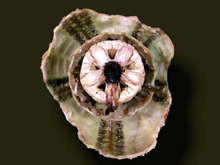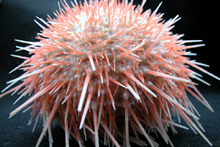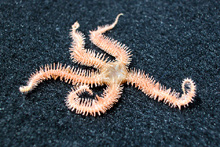
This broken urchin, with its Aristotle’s Lantern fully exposed but intact, was brought to the surface by the submersible. Photo credit: Art Howard, NAPRO. Click image for larger view.
Echinoderms: Stars of the Sea
August 27, 2003
Liz Baird
North Carolina Museum of
Natural Sciences
Co-principal Investigator
One of my clearest childhood memories was when we walked on a sandbar on the Florida Coast and discovered hundreds of sea stars bigger than my hand. I was amazed by the tube feet that tickled as one crawled over my hand, and wondered what something with a mouth in the center of its body might eat. My curiosity about these stars of the sea and their relatives continues, and I am constantly confronted by new questions during this Life on the Edge mission.
Translated, echinoderm means “spiny skin," and all members of this order share some similar characteristics. They have rough, sometimes very spiny skin, and their bodies tend to display radial symmetry. Most of the time their bodies can be evenly divided into five, or multiples of five, parts. The most commonly known groups of echinoderms include sea stars (also called starfish), sea urchins, and sand dollars.

One of the first echinoderms we retrieved during the Life on the Edge expedition was this beautiful pale orange and white sea urchin. Photo credit: Art Howard, NAPRO. Click image for larger view.
During the Life on the Edge mission, we have collected several representatives of this order. Each specimen inspires new questions. Unfortunately, we do not have many resources out here to help us identify and name the critters, much less answer the questions, but we do have a hand lens and a dissecting scope, as well as some excellent digital photographs, that allow us to make our own observations.
One of the first echinoderms we retrieved was a beautiful pale orange and white sea urchin. As it was almost spherical in shape and covered with spines and tube feet, it was difficult to imagine anything wanting to eat it. In some parts of the world, however, sea urchin gonads are considered a delicacy, and people eat them. When turned over, the urchin’s mouth is revealed. The mouth, made of five pointed plates, is controlled by an internal structure called an “Aristotle’s Lantern.” A broken urchin, with its Aristotle’s Lantern fully exposed but intact, was brought to the surface by the sub.
A subsequent dive retrieved another urchin, bright white in color. Orange and red are common colors in the deep ocean because they appear to be black in the turquoise blue light of the sea. So why was this second urchin white? How is the creature's white color advantageous? Is it a different species, or simply an individual variation in the population? Often, scientific investigations result in more questions than answers.
We have seen a greater diversity of sea stars during our dives. The Lophelia Banks, a deep-water (greater than 1,000 ft) coral habitat, is covered in brittle stars smaller than 1 inch long. In shallower areas, we have collected pentagon-shaped pillow stars with short, almost nonexistent arms, as well as the more traditional five-armed starfish. These specimens are very colorful, from deep purple to bright orange to pale yellow.

In observing the locomotion of both brittle stars (like the one pictured) and other sea stars, it appears that they move differently. Their locomotion requires further study. Photo credit: Art Howard, NAPRO. Click image for larger view.
Most sea stars have a small dot called a madraporite on their top surface. This dot is actually a water filter. The tube feet I felt as a child are controlled through a water-based system. When looking at the brittle stars, I realized that I did not see a madraporite on its small central disk. Even using the dissecting scope, I could not find one. This led me to wonder whether brittle stars had tube feet. I used the scope again, and examined the bottom of the brittle star, but did not see any tube feet. This made me wonder if brittle stars use a different means of locomotion than other sea stars. As I observed videotape of both brittle stars and other sea stars, it appeared to me that they move differently. This is certainly an area for further study.
One of the most unusual echinoderms was spotted by Jeremy Potter of the NOAA Office of Ocean Exploration during his dive in the the Johnson-Sea- Link II manned submersible. He described seeing a dark red, vase-shaped creature swimming past his porthole in the stern. His detailed description led us to identify it as a type of sea cucumber. When we watched the videos from the sub, the sea cucumber drifted past, confirming the identification. Surprisingly, this same species was sighted by our NOAA expedition coordinator last year.
Sea cucumbers, called holothurians, have long, hollow bodies with a front and back end. They come in a variety of shapes and sizes, from less than an inch to about 14 inches long. Although they can be found in shallow areas, they represent one of the largest groups in the deep ocean. In his book Deep Ocean, Tony Rice writes that sea cucumbers “make a living by 'hoovering' the surface of the mud for edible food scraps as they move across it.” The sea cucumber that Jeremy spotted is one that can take off from the ocean floor and move to new locations. It would be interesting to know what advantage is afforded this creature by being able to travel up into the water column.
My initial experience with sea stars as a child grew into my current wonderment at, and work with, the natural world. The Life on the Edge mission has led me to conclude that the sea, like the night sky, is full of wonderful stars. We call them echinoderms.





















